Lichens: Hybrid organisms
PDFLichens are considered to be “cousins” of fungi because, traditionally, they are made up of a combination of a fungus and either a green algae or a cyanobacterium or both. This association is called symbiosis, the fungus is a mycosymbiote, and the algae a photosymbiote.
Lichenized fungi belong mainly to the Ascomycetes (Ascomycota). Only a few lichens are formed from Basidiomycetes (Basidiomycota). As for algae, 90% of them are green algae, mainly Trebouxia (50 to 70% of lichens) and Trentepohlia. The rest is represented by cyanobacteria, of which the genus Nostoc is the most common. But this association is much more complex (see Lichens, surprising pioneering organisms).
1. How is a lichen built?
In gelatinous lichens such as Lathagrium, the fungus and cyanobacteria are homogeneously mixed : we speak of a homeomerous structure (Figure 1). In other lichens, the two partners are distributed differently to form a so-called heteromerous structure. In foliose lichens, for example, the structure shows layers (heteromerous stratified structure).
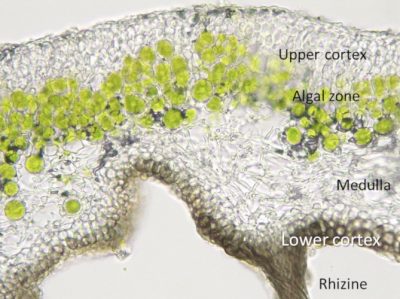
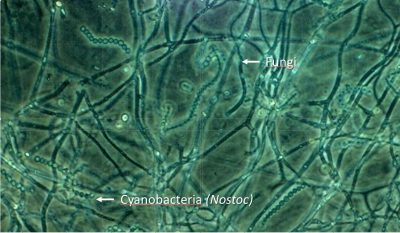
On a vertical section of the thallus, we recognize from top to bottom (Figure 2):
- an upper cortex formed only by fungi;
- an algal zone where fugi filaments and algae cells are intertwined;
- a medulla or medullary layer [1] where there are only fungi filaments;
- a lower cortex formed only by fungi from which escape filaments or rhizinae used to fix the thallus on the substrate.
2. Birth of a lichen
Two modes of reproduction can take place: vegetative and sexual reproduction.
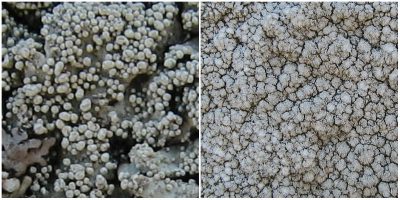
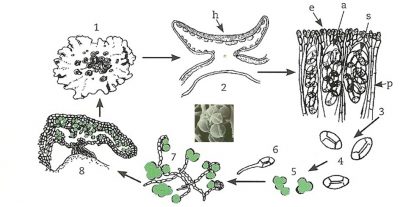
At maturity, the spores are violently expelled from the ascus then germinate on the substrate forming mycelial filaments. For a lichen to recover, the mycelium thus formed must meet a single algae. A new thallus can therefore be rebuilt and give back an adult thallus. The symbiosis then gradually recovers.
Notes and references
Cover image. Xanthoparmelia conspersa. [Source: © J. Asta]
[1] In crustose lichens, the medulla consists of loosely packed hyphae that are inseparable from the substrate.
地衣:共生生物
PDF地衣被认为是真菌的“近亲”,传统意义上,它们是由真菌与绿藻或蓝藻,或与绿藻和蓝藻的结合组成的。这种关系被称为共生,真菌是真菌共生体,藻类是光合共生体。地衣真菌主要属于子囊菌纲(子囊菌门)。只有少数地衣是由担子菌纲(担子菌门)形成的。藻类中90%为绿藻,主要为共球藻属(50—70%的地衣)和橘色藻属。其余以蓝藻为代表,其中念珠藻属是最常见的。这种共生关系很复杂(参见《地衣,令人惊讶的开拓者》)。
1.地衣是如何形成的?
在胶状地衣(如胶耳衣)中,真菌和蓝藻是均匀混合的:我们称之为同层结构(图1)。在其他地衣中,这两个伙伴的分布不同,形成了所谓的异层结构。例如,在叶状地衣中,其结构呈层状(异层结构)。
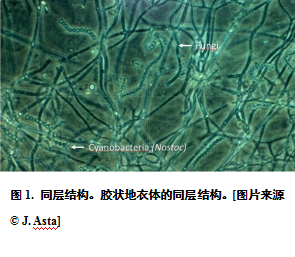
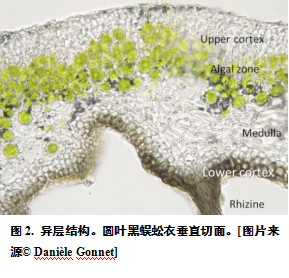
在地衣体的垂直切面上,我们可以看到(图2,顺序从上到下):
- 上皮层仅由真菌形成;
- 藻胞层为真菌菌丝与藻细胞交织区域;
- 髓层仅有菌丝存在[1];
- 下皮层仅由真菌形成,从其中逸出用于在基质上固定地衣体的丝或假根。
2.地衣的繁殖
地衣有两种繁殖方式:无性繁殖和有性繁殖。
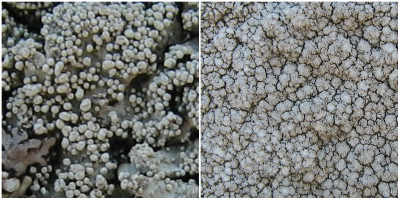
[图片来源: © J. Asta]
无性繁殖是通过地衣体的裂片和自然断裂进行的。例如,Lepra amara地衣体上点缀着粉状斑点,即粉芽。每个粉芽堆的皮层裂开,真菌丝和藻类形成的粉尘和粉芽从中逸散,这些粉尘可以被雨、风、动物等携带,从而传播繁殖。皮层仍然存在的地衣体扩张后形成裂芽,当地衣体相互摩擦,或有昆虫通过时,这些裂芽可以分离,也可以传播(图3)。
藻类只进行有丝分裂(无性生殖),只有真菌进行有性繁殖。此处以丽石黄衣为例(图4)。丽石黄衣的生殖器官或子囊器官有一个可育的子实层组织,由子囊组成,子囊可以产生孢子。每个子囊含有8个孢子,2个单细胞腔,由中间增厚层隔开,使孢子呈沙漏状。在子囊之间是不育的或侧丝碎片,其有颜色的末端延伸出子囊的顶端,构成囊层被。
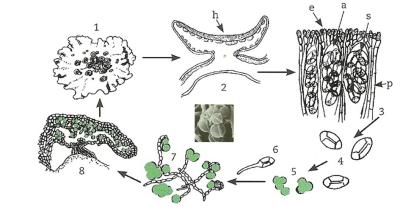
成熟后,孢子从子囊中猛烈地排出,落在基质上发芽后形成菌丝。为了使地衣恢复,这样形成的菌丝体必须与单个藻类相遇。这样一来,一个新的地衣体可以产生,并长成一个成年的地衣体,这种共生关系便可以逐渐恢复。
注释及引用:
封面图片:黄梅地衣(Xanthoparmelia conspersa)。[来源: © J. Asta]
[1] 壳状地衣的髓层由松散堆积的菌丝组成,与基质密不可分。




